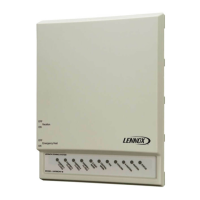GAS FURNACE
Page 26
505023M 08/11
Set the upper limit of blower CFM as follows:
1. Determine the maximum system CFM requirements (sum of all the individual zones).
2. From the Blower Motor Performance tables (see G71MPP, SLP98, SL280V, EL296V Furnace Installation Instructions)
determine the HIGH speed cool DIP switch setting that corresponds to this CFM.
3. Set the HIGH speed cool DIP switch setting on the integrated control to this value.
NOTE − The lower limit of blower CFM is factory set. It is not field adjustable.
The minimum airflow achieved by the G71MPP, SLP98, SL280V, EL296V when connected to a Harmony IIIt zone control
is listed in the table 6 (see page 14).
A 3% duty cycle corres
ponds to the minimum CFM, and a 97% duty cycle corresponds to the maximum CFM.
NOTE − Any on/off delays present for a heating or cooling sequence are still present with Harmony IIIt zone control opera-
tion.
VSM Furnace System Operation (G71MPP, SLP98, SL280V, EL296V)
The dehumidification on−board clippable link W914 Dehum − Harmony (R to DS) on the G71MPP, SLP98, SL280V, and
EL29V integrated control must be cut for operation with the Harmony III zone control (see figure 18). Once the link is cut,
the presence of the Harmony III zone control system, versus a standard dehumidification control, is automatically de-
tected by the integrated control.
IMPORTANT − DO NOT alter blower harness!
When the integrated control is properly connected to a Harmony IIIt zone control, operation is as follows:
S Integrated control DIP switches 1 and 2, which configure the control for operation with various types of thermostats,
are ignored.
S The zone control sends a W1 Signal to the furnace which goes through its normal ignition sequence as described in
the G71MPP, SLP98, SL280V, and EL29V installation instructions.
S The blower will start and operate at the minimum blower speed after a 45 second delay.
S After the temperature of the DAS rises above 100ºF the zone control will provide a PWM signal to the furnace on termi-
nal DS based upon the Zone PIAB Jumper selections (and the heating air reduction jumper).
S The blower speed (CFM) is set according to the pulse width modulated (PWM) signal from the Harmony IIIt zone con-
trol.
S The blower speed adjusts immediately with PWM adjustments.
S The furnace firing rate is based on current operating CFM and internal lookup table for midpoint temperature rise. If
resulting firing rate is below minimum firing rate, it will operate at minimum fire rate. Accordingly, if resulting firing rate
is above maximum firing rate, it will operate at maximum firing rate.
S Firing rate adjusts anytime the PWM deviates by more than 5% (e.g. 60% > 65%).
NOTE − Integrated control DIP switches 14 thru 19 are not disabled, and can be used in conjunction with Harmony III to
increase or decrease airflow volume during heating operation.
NOTE − DIP switches 14−19 adjust firing rate when Harmony is detected. Air volume is controlled by Harmony. The
furnace looks at air volume and determines proper firing rate based on DIP switch 14−19 settings. See G71MPP &
SLP98 Installation Instructions for adjustment options.
S Integrated Control W2 terminal to Harmony IIIt zone control:
Since the furnace automatically adjusts firing rate to match CFM to achieve a target temperature rise, connection of
Harmony IIIt zone control to W2 terminal on the integrated control is not required.
With W2 connected, lower firing rates can be used for W1 demand usually resulting in greater comfort levels per zone. If
temperature cannot be maintained, then W2 will quickly increase firing rates to satisfy demand.
If discharge air temperature is too low, the integrated control W2 can be connected to Harmony IIIt zone control to
cause the furnace to increase firing rate. Every two minutes, the integrated control looks at W2. If W2 is ON, the firing
rate increases by 5%. This 5% increase is added to the desired firing rate as determined by the PWM. Therefore, if a
50% duty cycle corresponds to a 70% firing rate, after 2 minutes of W2, that same 50% duty cycle will correspond to a
75% firing rate. This will last for the remainder of the heat cycle.
When W2 goes from ON to OFF, the integrated control decreases the firing rate by 5%.

